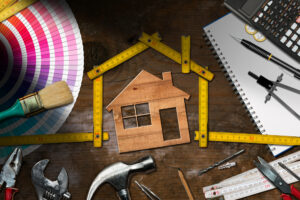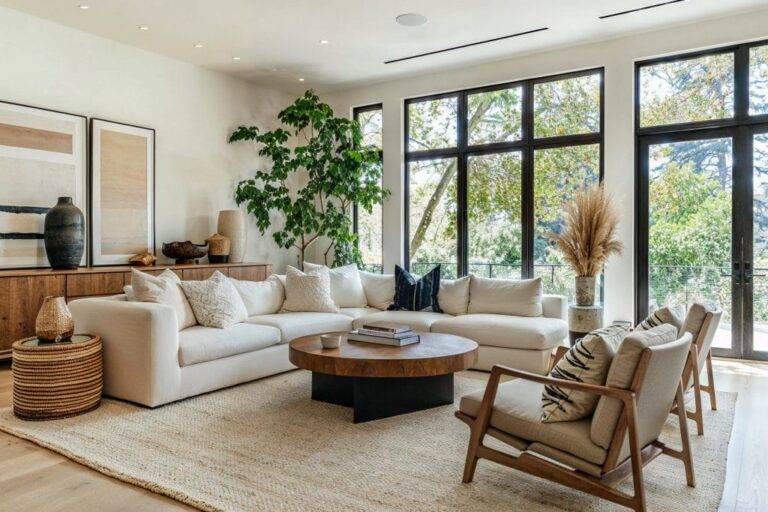Home décor is a deeply personal expression of style and creativity. Over the years, the DIY (Do It Yourself) movement has gained significant momentum, allowing homeowners and renters alike to bring their visions to life without the hefty price tags that often accompany professional interior design services. DIY décor not only encourages self-expression but also provides an affordable avenue to refresh and transform living spaces. In recent years, however, DIY home décor trends have evolved, embracing innovative techniques, sustainable practices, and bold aesthetics. From eco-conscious furniture refurbishing to the incorporation of technology, DIY has become more than just a craft—it’s a transformative approach to how we design and personalize our homes.
As homeowners increasingly seek customization, sustainability, and affordability in their home design projects, new trends in DIY are emerging that push the boundaries of what is possible. These trends are not only reshaping how we approach home décor, but they are also empowering individuals to create unique, meaningful spaces. Here, we explore the latest DIY trends that are transforming home décor, highlighting the creative potential that lies in these exciting developments.
1. Sustainable DIY Décor: Reuse, Repurpose, and Recycle
Sustainability has become a central theme in modern living, and it’s no surprise that this ethos has found its way into DIY home décor. Consumers are becoming increasingly aware of the environmental impact of mass production and are seeking ways to reduce waste and minimize their carbon footprint. This has sparked a resurgence in the practice of repurposing old furniture, using reclaimed materials, and embracing upcycling projects.
One of the most notable trends in sustainable DIY is the repurposing of vintage or secondhand furniture. With a little creativity and elbow grease, outdated pieces can be transformed into statement items that suit contemporary tastes. From giving an old dresser a fresh coat of paint and new hardware to converting a worn-out wooden ladder into a rustic bookshelf, the possibilities are endless. This not only reduces waste but also adds a unique, personal touch to a home.
Additionally, the use of reclaimed wood has seen a surge in popularity, especially in rustic, industrial, and farmhouse-style décor. Whether it’s an old pallet turned into a coffee table or salvaged timber used to create a chic headboard, the charm of reclaimed materials lies in their history and texture. These pieces can become the focal point of a room, while also reducing the demand for new, often unsustainable, resources.
2. Smart Home Integration in DIY Projects
As technology becomes more integrated into daily life, DIY enthusiasts are incorporating smart home devices into their projects to enhance convenience and functionality. From smart lighting systems to automated thermostats, DIYers are finding creative ways to fuse technology with design, making their homes both more efficient and aesthetically pleasing.
A popular trend is the integration of smart lighting into DIY home décor projects. Instead of relying solely on traditional light fixtures, many DIYers are installing smart bulbs or creating their own custom lighting systems using programmable LED strips. These DIY smart lighting projects not only allow homeowners to control the ambiance of a room through their smartphone or voice assistant but also provide an opportunity to create unique lighting designs that reflect their personal style.
In addition to lighting, DIYers are also incorporating smart home systems into furniture. For example, a custom-built entertainment center might feature built-in charging stations for electronics, hidden speakers, or wireless charging pads, all neatly integrated into the furniture’s design. This seamless integration of technology ensures that the home is not only stylish but also functional and connected in the most efficient way possible.
3. Biophilic Design and Indoor Plants
Biophilic design—an approach that seeks to connect people with nature—has become one of the most influential trends in interior design. For DIYers, biophilic design offers an exciting opportunity to incorporate natural elements into home décor, creating calming, nature-inspired spaces.
Indoor plants are central to this movement, and DIY enthusiasts are finding creative ways to display them. Vertical gardens, wall-mounted planters, and geometric terrariums are just a few of the ways plants are being integrated into home décor. With the rise of urban living, many people are looking to bring the outdoors in, and plants offer a low-cost and highly effective solution to infuse life into a room.
Moreover, biophilic design extends beyond plants to other natural materials, such as stone, wood, and natural fibers. DIYers are incorporating these elements into their projects to create organic, soothing environments. For instance, a rustic wood-framed mirror can bring a touch of nature into a bathroom, while woven jute rugs can soften the feel of a living room. Whether it’s through the use of raw materials or the strategic placement of plants, biophilic design enhances well-being and adds a natural elegance to home décor.
4. Textural Contrast and DIY Wall Treatments
One of the most exciting trends in DIY décor involves the creative use of textures to add depth and interest to a space. By combining different materials, DIYers are able to create visually striking interiors that feel dynamic and layered. Textural contrast has become a key element in modern home design, from tactile wallpaper to hand-painted murals.
A growing trend is the use of textured wall treatments, such as faux brick, wood paneling, or plaster finishes, to create focal points in a room. These treatments can be applied to accent walls or entire rooms, transforming plain surfaces into works of art. For example, a DIYer might use joint compound and stencils to create an intricate textured design on a feature wall, while others are experimenting with painted plaster to achieve a smooth, modern finish that mimics high-end designer walls.
Another popular technique is creating custom wall art using mixed media. DIYers are combining materials such as fabric, wood, and metal to create unique, three-dimensional pieces of art that become a central design feature. These textured wall treatments add character to any room and are a fantastic way to infuse personality into your space without spending a fortune.
5. Maximalism and Bold, Eclectic Décor
While minimalism has long been a dominant force in home décor, there has been a noticeable shift toward maximalism in recent years. This trend embraces vibrant colours, bold patterns, and eclectic combinations of furniture and accessories. DIYers are increasingly drawn to creating spaces that feel expressive and full of character, often mixing and matching styles from different eras and cultures.
Maximalist DIY décor encourages layering, whether it’s through bright, mismatched textiles, oversized furniture pieces, or collections of artwork. In practice, this means experimenting with different colour schemes and mixing textures like velvet, leather, and linen. DIYers are taking risks, blending ornate vintage furniture with modern, sleek accessories, or pairing whimsical décor with statement lighting.
A DIY maximalist project might involve refurbishing a vintage chair with a luxurious, patterned fabric or creating an over-the-top gallery wall full of eclectic framed pieces. The goal is to create a space that feels lived-in, personal, and full of energy. For those who love bold design choices, maximalism is a wonderful way to showcase creativity and individuality.
6. DIY Furniture Upcycling and Customization
The trend of upcycling old furniture has experienced a major revival, with DIYers seeking to breathe new life into discarded or outdated pieces. Whether it’s transforming a mid-century coffee table with a fresh coat of paint or completely reimagining an old dresser with new legs and handles, upcycling provides endless opportunities to inject personality into your furniture while reducing waste.
Customization also plays a large role in this trend. DIYers are experimenting with different painting techniques, such as ombre or geometric designs, to create one-of-a-kind pieces. Adding personalized touches like custom knobs, hand-painted patterns, or unique upholstery can completely transform a piece of furniture from drab to fab.
Conclusion
The DIY home décor movement is constantly evolving, with new trends emerging that embrace creativity, sustainability, and the desire for personalization. From repurposing old furniture and incorporating smart technology to creating textured wall treatments and embracing biophilic design, DIYers now have more tools than ever to transform their homes into unique, functional, and inspiring spaces. These new trends reflect a broader cultural shift towards customization, sustainability, and self-expression in home design. Whether you’re a seasoned DIY enthusiast or a novice just beginning your journey, these trends offer exciting possibilities for creating a home that reflects your personal style and values. The future of DIY home décor is bright, and it’s clear that the only limit is your imagination.
















